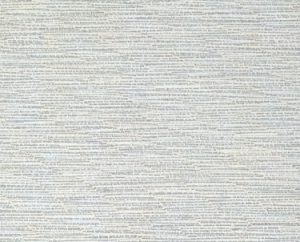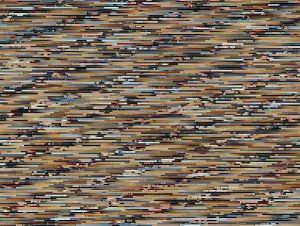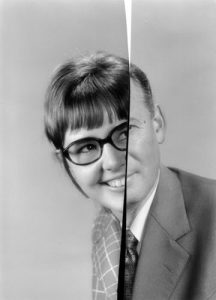
This series of 32 photographs is based on the archive of a commercial photographer who donated the negatives he didn’t need any more to the Institute for the Reprocessing of Used Photographs. The photographer cut his negatives to prevent their future use. This attempt to preclude new prints triggered the creation of photographs that would not exist without the attempted destruction. Consistent point of view, consistent light, and consistent poses allowed the combination of two negatives into one single image. The resulting photographs are portraits of non-existing persons. They are based on the genetic pool of the population of a small town in Bavaria. Like in genetic engineering, existing information was dismantled and spliced to create formerly unknown mutations, playing with genetic inheritance, age, gender, and personality.
2014
digital print, b/w
21 x 14.8 cm, 36 pages
softcover, saddle-stitched
50 copies
Statics

The series Statics (1995–2003) is an artistic reply to the aggressive visual pollution and excess information in modern society. Media fall-out such as garbage photos, advertising leaflets, unsolicited mail, redundant books etc. was the raw material that was recycled. Using an office shredder, this existing (paper-based) information was sliced, turning information into meaningless matter. The resulting strips were gathered to create visual fields with specific tonalities and colours that reflect the original content.
2014 (the 2013 print-on-demand edition is discontinued)
digital print, colour
21 x 14.8 cm, 32 pages
softcover, saddle-stitched
50 copies
Erste allgemeine Altfotosammlung

1991 by Edition Fricke & Schmid
offset, b/w
21 x 14.8 cm, 64 pages + 1 original photograph
softcover
400 copies, numbered
ISBN 3 927365 20 3
Statics (1995–2003)

^ Statics (invitation cards for art exhibitions), 1996, 60 x 70 cm

^ Statics (baseball cards 2), 1996, 40 x 50 cm

^ Statics (Walter Benjamin, Das Kunstwerk im Zeitalter seiner technischen Reproduzierbarkeit), 1997, 40 x 50 cm

^ Statics (pinup postcards), 1998, 50 x 60 cm

^ Statics (men’s fashion catalogue), 1999, 60 x 80 cm

^ Statics (women’s fashion catalogue), 1999, 60 x 80 cm

^ Statics (postcards of sunsets 2), 2003, 50 x 60 cm

^ Statics (Marlboro billboard), 2002, 235 x 315 cm, Foto Biënnale Rotterdam 2003

^ The Frances Young Tang Teaching Museum and Art Gallery at Skidmore College, Saratoga Springs, NY 2007
Statics is a series of 81 pictures made from shredded photographs and printed matter.
Shredded photographs and printed matter mounted on archival board, unique works, various sizes.
A catalogue is available in the series of white books.
Photogenetic Drafts (1991)





This series of 32 photographs is based on the archive of a commercial photographer who donated the negatives he didn’t need any more to The Institute for the Reprocessing of Used Photographs. The photographer cut his negatives to prevent their future use. This attempt to preclude new prints triggered the creation of photographs that would not exist without the attempted destruction. Consistent point of view, consistent light, and consistent poses allowed the combination of two negatives into one single image. The resulting photographs are portraits of non-existing persons. They are based on the genetic pool of the population of a small town in Bavaria. Like in genetic engineering, existing information was dismantled and spliced to create formerly unknown mutations, playing with genetic inheritance, age, gender, and personality.
Cluster of portraits (178 x 314 cm) consisting of thirty-two b/w prints (37 x 28 cm each)
Photogenetic Drafts #s 4, 7, 8, 10, 15, 20, 24, 32 were reprinted in 2001 (48 x 34 cm each, edition of 3 copies + 1 AP)
A catalogue is available in the series of white books.
Erste allgemeine Altfotosammlung (1990)

First General Collection of Used Photographs
Year in and year out an unimaginable number of photographs are produced worldwide. Virtually every day each of us enlarges this gigantic mountain of photographs, without giving the consequences a second thought. But while photography seems a harmless leisure pursuit, the chemicals contained in all photographs pose enormous dangers to our health. What‘s more, photographs in such quantities increase visual pollution and undermine our thinking power—to say nothing of the moral dangers they pose for our children.
In these conditions it would be best if we stopped making photographs altogether—but in many cases this is hardly possible. Therefore, it is essential to professionally dispose of all photographs once they are no longer needed. Experts from East and West have warned us for decades about the impending, catastrophic consequences of the photo boom, but their pleas have fallen on deaf ears among those responsible in industry and politics. Today billions of used photographs are stored improperly in homes and businesses, waiting for desparately needed recycling facilities.
The Institute for the Reprocessing of Used Photographs, privately founded in 1990, offers a clear path out of this seemingly inescapable situation. The Institute maintains all facilities necessary to professionally reprocess photos of all kinds—or, in hopeless cases, dispose of them ecologically. We collect used, abandoned and unfashionable photographs in black and white or color, including instant photographs, photobooth strips, entire photo albums, contact sheets, test strips, negatives and slides, as well as damaged and shredded items, in both small and large quantities.
Remember, used photographs do not belong in the household garbage—they need special disposal. Many photographs can serve a new and useful purpose after reprocessing. For the sake of our environment, send your used photographs to the Institute for the Reprocessing of Used Photographs.
Participation in this recycling program is guaranteed free of charge!


^
Torn-up studio portraits mounted on archival board, 50 x 40 cm each
